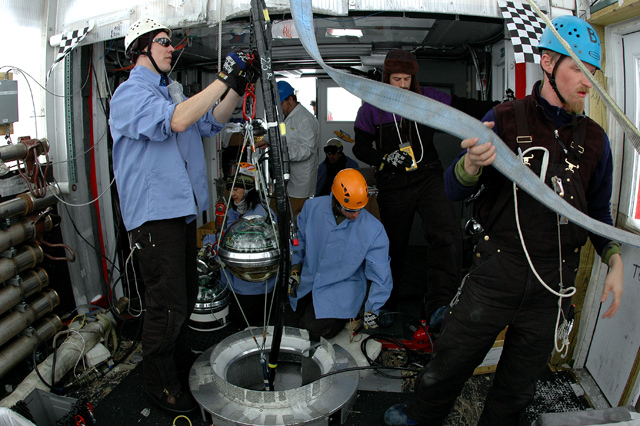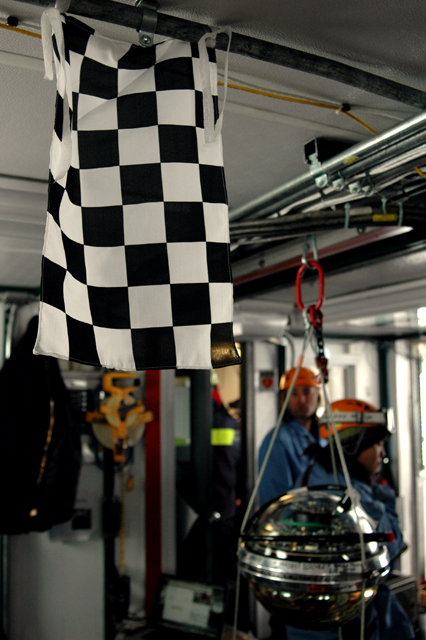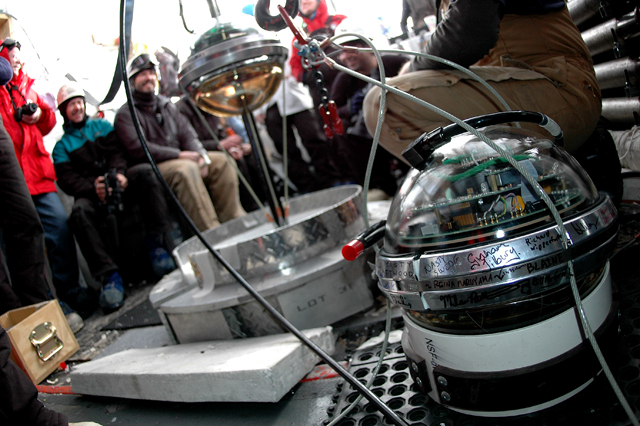Stringing it togetherIceCube team completes massive neutrino detector at South PolePosted December 31, 2010
The conflicting emotions were palpable in the crowded drill tower where all eyes and cameras were on the basketball-sized instrument latched onto a cable. The shout “DOMs away” would send it and the rest of the 59 digital optical modules on the string deep into the ice sheet below the South Pole Station The command had been uttered hundreds of times since the IceCube Neutrino Observatory But on Dec. 18, 2010 (local New Zealand time), there was an air of reluctance, even as the anticipation and excitement built. This was the 86th and final string deployment for the subglacial neutrino detector, marking the culmination of seven seasons of construction at the U.S. Antarctic Program’s “It’s been a long ride. It was hard to imagine at the time when we started in the early AMANDA But they did make it. About 4:12 p.m., the last DOM disappeared down the hole created by a powerful hotwater drill the day before. And at two minutes before 6 p.m. the final string was secured at the surface until the hole refreezes, entombing the modules forever. “It’s bittersweet,” said Dennis Duling, IceCube drill manager in charge of the operation and maintenance of the equipment required to bore deep holes into the world’s highest and biggest ice sheet. “Damn glad it’s done. It’s a lot of work. It’s tiring. It’s a good, hard pace throughout the season. But I’m going to hate to see it end. I’m working with the best people on Earth,” added Duling, who has been on site for all 86 holes. Big goalsThe National Science Foundation An array a cubic kilometer in size with more than 5,000 specially designed photomultipliers, IceCube is mind-boggling big, looking for something inconceivably small — a subatomic particle called a neutrino. The most abundant particle in the universe aside from photons (light particles), high-energy neutrinos result from violent events in the far-flung corners of the universe, such as exploding stars or by the formation of black holes. Physicists believe neutrinos contain information about such high-energy events thanks to their ability to make a straight beeline through the universe without changing course. IceCube can help scientists trace the neutrinos back to their place of origin by capturing the incredibly brief interaction of the particles with other atoms as they speed through ice. The collision produces another particle called a muon, which leaves a trail of blue light in its wake. It’s that flash of light that IceCube captures, using strings of DOMs frozen in the ice sheet between 1.45 and 2.45 kilometers below the surface where the ice is exceptionally clear. “It’s a discovery machine; it’s a discovery instrument. They could not guarantee, as we built it, we would immediately get something we would expect to get,” explained Vladimir Papitashvili, program director for Antarctic Aeronomy and Astrophysics at NSF’s Office of Polar Programs “I think it’s an excellent investment. The results could be absolutely fantastic, something that could be completely unexpected,” Papitashvili added.1 2 3 Next |



For USAP Participants |
For The Public |
For Researchers and EducatorsContact UsU.S. National Science FoundationOffice of Polar Programs Geosciences Directorate 2415 Eisenhower Avenue, Suite W7100 Alexandria, VA 22314 Sign up for the NSF Office of Polar Programs newsletter and events. Feedback Form |





